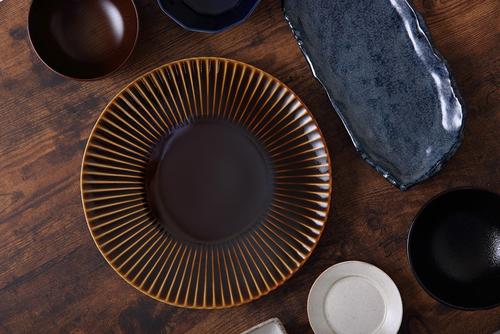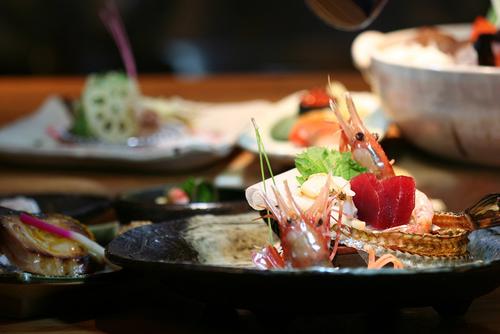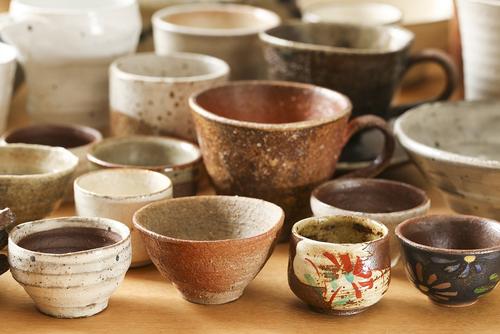Japanese tableware, with its unique materials and patterns, is extremely popular as a souvenir for overseas visitors.
However, when introducing the appeal of Japanese tableware to foreigners, we are surprised to hear many people say, "I don't understand its specific features."
In this article, we would like to clearly explain the basic types of Japanese tableware, as well as the points and benefits to consider when choosing tableware that suits you.
What is Japanese tableware? Basic types to know before choosing

Japanese tableware is tableware made to suit Japan's unique food culture.
If you look at the types below, you will be able to get a better idea of their characteristics.
the size of the vessel
It is common for many Japanese tableware to have different uses depending on their size.
The size is expressed in the traditional shakkanho system, such as "three-inch plate" or "eight-inch plate."
Small plates (small plates): condiment holders, soy sauce holders
● Medium plate: a container for sweets, especially a plate
●Large plate: pasta, side dishes
●Large bowl: simmered dishes, etc.
Shape of the vessel
One thing to note about the shape of Japanese tableware is that many small and medium-sized plates are easy to pick up.
This is a characteristic that is connected to the culture of "holding the bowl in your hand and using chopsticks" when eating Japanese food.
The ease of holding the dishes is an appeal not found in Western tableware that requires a knife and fork.
In addition, in kaiseki cuisine, appetizers are sometimes served in small bowls with unusual shapes such as diamonds or squares.
Material of the vessel
The wide variety of materials used in Japanese tableware is closely related to Japanese cuisine, which places great importance on the feel of the tableware.
The two most common types of materials are earth and stone.
Earthenware, commonly known as pottery, has a porous and rough texture, while stoneware, which is porcelain, is smooth and allows light to pass through easily.
One of the appeals of Japanese tableware is that each piece has a different feel, allowing you to choose the piece that suits you best based on the way it feels when you hold it.
Pattern on the vessel
Japanese tableware comes in a wide variety of patterns, including plants, animals, and geometric designs.
Additionally, for ceremonial occasions such as weddings and funerals where family members gather, or for kaiseki cuisine, Japanese tableware with auspicious patterns like the ones shown below is often chosen.
● Shippo: A pattern of circular, eternal chains, representing wishes for good fortune and harmony.
● Six gourds: A pattern associated with good health and good fortune, a lucky pattern that wards off disasters and brings good fortune.
Seigaiha: A pattern of repeated layers of semicircles resembling waves, symbolizing a peaceful life.
The appeal of Japanese tableware is that you can choose the pattern of the dish not only based on the appearance and design, but also on auspicious meanings and wishes.
Points and benefits of choosing the Japanese tableware that suits you

When purchasing Japanese tableware for your first time living alone or as a newlywed, we recommend keeping the following points in mind when selecting your tableware.
One soup and three dishes
The simplest way to choose Japanese tableware for home use is to base it on the basic Japanese diet of one soup and three side dishes.
●Rice bowl
●Soup bowl
●Medium plate
●Small plate
Small bowl
If you prepare these dishes first, you can easily create a well-balanced meal consisting of one soup and three side dishes by simply deciding what to put on each plate.
The size that suits your needs
As mentioned above, when it comes to Japanese tableware, the type of food that is suitable for each type of dish is roughly determined by its type: small plate, small bowl, medium-sized plate, etc. Therefore, if you are planning to purchase Japanese tableware, it is recommended that you think about what will be placed on each dish, rather than simply choosing based on your preference for color and pattern.
For example, if you are starting to buy Japanese tableware for a household of one or two people, you will likely find more use in a 5-inch plate, which is about 15cm and can be used as a side plate or cake plate, than a large 7-inch plate, which is used for main dishes or one-plate meals.
There are many artists and a wide variety of designs
For those who value design, we recommend collecting Japanese tableware by artists active in production areas such as Kutani ware and Mashiko ware. One of the appeals of tableware by your favorite artist is that it is easy to coordinate the entire dining table just by changing the size. Also, if you have a favorite artist, you will have the opportunity to enjoy the release of their new works and attend their events.
In the case of an artist who has produced many works, you can also enjoy the collector's pleasure of collecting their Japanese tableware.
Durable and easy to use, it heats up quickly and cools down quickly, making it ideal for cooking.
Japanese tableware is highly durable and does not allow food to escape easily, making it highly recommended for those who value practicality.
For example, ceramics have the advantage of retaining heat well, so even if you serve meat and potatoes first, the food will not cool down while the family is eating. On the other hand, when it comes to porcelain, which is often baked at high temperatures, there are many types that can be used in the microwave.
If we pay attention to the practicality of Japanese tableware, I think it will help reduce the burden on women who have to think about the order in which to serve food.
summary

This time, for those who are interested in Japanese tableware, we have compiled a list of detailed characteristics and points to consider when choosing tableware that suits you. Recently, the Japanese tableware industry has seen the emergence of many designs that match menus overseas.
If you're interested, try to find the plates that suit your lifestyle.
This article has been partially re-edited by KARUTA from an article originally published on "Nihongo Biyori."
Any unauthorized reproduction or use of the contents, text, images, illustrations, etc. of this website is strictly prohibited.
